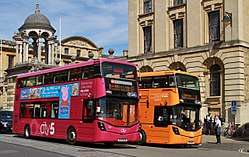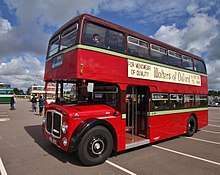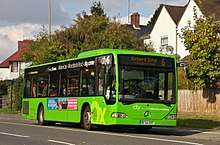Oxford Bus Company
Oxford Bus Company is the trading name of The City of Oxford Motor Services Ltd.[1] It is a bus operator serving the city and surrounding area of Oxford, England. It is a subsidiary of the Go-Ahead Group.
 | |
 Route-branded Wright StreetDeck buses outside The Queen's College, Oxford in 2017 | |
| Slogan | We're all about Oxford |
|---|---|
| Parent | Go-Ahead Group |
| Founded | 1881 |
| Headquarters | The City of Oxford Motor Services Ltd., Cowley House, Watlington Road, Cowley, Oxford, OX4 6GA |
| Service area | Oxfordshire |
| Service type | Bus and coach services |
| Destinations | Abingdon, Bicester, Gatwick, Hearthrow, Kidlington, Oxford. |
| Fleet | 190 (September 2018) |
| Chief executive | Phil Southall |
| Website | Oxford Bus Company |
History
Horse trams and horse buses
The City of Oxford and District Tramway Company served Oxford with horse-drawn trams from 1881.[2][3] By 1898 its network served Abingdon Road, Banbury Road, Cowley Road, Walton Street and both Oxford and Oxford Rewley Road railway stations.[4]
Horse bus services developed to complement the tramway network. By the early 20th century both Iffley Road and Woodstock Road were horse bus routes. On Saturdays only there were horse buses from Headington to the city centre and from Cowley village to the tram terminus in Cowley Road.[5]
In 1906 the City of Oxford Electric Traction Company took over from the City of Oxford and District Tramway Company.[1][5] It planned to electrify and expand the network, but was defeated by local opposition.[6]
Motor buses
In 1913–14, and under threat of competition from William Morris and Frank Gray, the tram company replaced its trams and horse buses with Daimler motor buses.[7][8]
In 1921, the company was renamed City of Oxford Motor Services Limited (COMS). It continued to expand its operations into the surrounding countryside. From the 1930s, COMS was controlled by British Electric Traction, with the Great Western Railway having a minority shareholding. The fleet livery was red with maroon and pale green relief. Most of its buses were built on AEC chassis and running gear. Numerous former COMS buses have been preserved, including a large and notable collection at the Oxford Bus Museum in Long Hanborough in Oxfordshire.

In 1969 COMS became a subsidiary of the National Bus Company. Greater integration of city and country services began. In 1971, the Oxford – London coach operator South Midland, which had been controlled by the neighbouring Thames Valley Traction company, was transferred to COMS and the fleet name for the entire operation became Oxford South Midland.
An acute problem for the operator was the competition for staff with Morris Motors, whose Cowley factory was near the Oxford garage. One response was to move to one person operation of buses in the 1970s.[9]
After some trials, the Oxford company established the city's pioneering park and ride bus services in 1978. In the same year, the London express service began, using its present route.
In 1983, COMS was split into separate Oxford and South Midland units. The Oxford Bus Company was allocated the Oxford city services and the London routes, and South Midland was allocated the remainder of the network. Both companies were subject to management buyouts. The South Midland company was soon resold to Thames Transit (later Stagecoach South Midlands), which introduced minibus competition. Oxford Bus Company tried to counter this with minibuses under the Oxford City Nipper brand name.

In 1990, the Oxford Bus Company acquired the High Wycombe operations of the Bee Line, and ran them under the Wycombe Bus brand name. In March 1994, the Go-Ahead Group bought Oxford Bus Company. In 2000, Go-Ahead sold the High Wycombe operation to Arriva. The company's long-established main depot in Cowley Road, Oxford was closed in 2004, replaced by a new depot opened in Watlington Road.[10]
In July 2009, Oxford Bus Company took over Oxford Brookes University's BrookesBus contract.[11][12]
Go-Ahead bought Thames Travel in 2011 and Carousel Buses in 2012. They now share Oxford Bus Company management but retain their separate identities.[13][14][15][16]
In October 2019, it was announced that the X90 service between Oxford and London would be withdrawn from 4 January 2020, due to a 35% fall in passenger numbers since 2015 causing the route to be unprofitable.[17][18]
Bus location technology

All Oxford Bus Company buses and coaches have automatic vehicle location (AVL) equipment installed which works via GPS technology.[19] The AVL equipment installed on each bus or coach gives geographical location to within a few metres and is updating central control room every few seconds. This information technology can therefore be seen in real time at the central control room, which helps in managing the fleet.[20]
The AVL equipment is also coupled to a real-time passenger information system at over 250 bus stop display screens around Oxford City and surrounding towns, and via a smartphone app. This coupled information technology system gives the public "predicted times" of bus and coach services around Oxford City and surrounding towns.[20][21][22]
Oxfordshire County Council also uses this information technology to provide traffic-light priority for buses at some road junctions.[21]
The real-time passenger information system is managed by OxonTime, which is a partnership between various bus companies and Oxfordshire County Council.[20][21]
Brands
Oxford Bus Company currently operates services under five brands:
| Brand | Used for | Services | Image |
|---|---|---|---|
| City | Local buses in and around Oxford. Most are branded with a livery and graphics specific to their usual route. | City 2/2A/2B (blue), City 3/3A (yellow), City 4/4A/4B/4C (purple), City 5 (pink), City 6/6C (green), City 8/9 (orange), City 35/35A/35B (maroon). Others (including City 13/X3/X13, City 250) are in a generic red livery. |  |
| Park & Ride | Limited stop buses from five peripheral park and ride car parks around the city | 300, 400, 500 |  |
| Airline | Express coaches linking Oxford with Heathrow and Gatwick airports | LHR, LGW, OXF |  |
| BROOKESbus | Local buses linking campuses and halls of Oxford Brookes University, but open to all passengers | U1 (NU1), U5 (NU5) |  |
| PickMeUp | Demand responsive transport booked via the PickMeUp app. | No set route. Service limited to east Oxford and the city centre. This service will be withdrawn after 20 June 2020. |  |
Fleet
As of May 2019 the fleet consisted of 190 buses and coaches, of which at least 74 are hybrid buses.[23]
References
- "The City of Oxford Motor Services Limited". Companies House. Retrieved 6 August 2017. Company Number 91106
- Crossley, Alan; Elrington, CR (eds.); Chance, Eleanor; Colvin, Christina; Cooper, Janet; Day, CJ; Hassall, TG; Selwyn, Nesta (1979). A History of the County of Oxford. Victoria County History. 4: The City of Oxford. pp. 350–364. ISBN 978-019722714-5. Retrieved 6 August 2017.CS1 maint: extra text: authors list (link)
- Hart 1972, p. 222.
- Hart 1972, p. 223.
- Hart 1972, p. 224.
- Hart 1972, p. 225.
- Chipperfield, John (15 March 2010). "Postcard marked passing of Oxford's trams". Oxford Mail. Newsquest Oxfordshire. Retrieved 6 August 2017.
- "Oxford and District Tramways Bill". Parliamentary Debates (Hansard). United Kingdom: House of Commons. 22 July 1914. col. 591–599. Retrieved 6 August 2017.
- Jolly, Stephen; Taylor, Nick (2003). The Book of Oxford Buses and Trams. Oxford Bus Museum Trust. ISBN 978-0-9506739-2-9.
- Ashworth, Phil (2006). The Oxford Bus Company – the first 125 years. Oxford: Oxford Bus Company.
- "Oxford Bus Company wins Brooks bus contract from rivals Stagecoach". TransportXtra. Landor Associates. 6 November 2008. Archived from the original on 13 October 2013.
- Crowe, Malcolm (3 July 2009). "Issue 292". The Oxford & Chilterns Bus Page. Retrieved 6 August 2017.
- "Oxford Bus Company". Go-Ahead Group. Archived from the original on 15 April 2012.
- Smith, Andrew (29 May 2011). "No changes at Thames Travel says outgoing boss". Oxford Mail. Newsquest Oxfordshire. Retrieved 6 August 2017.
- "Go-Ahead buys 35-vehicle Thames Travel". Bus and Coach. Plum Publishing. 8 June 2011. Retrieved 6 August 2017.
- "Go-Ahead Acquires Carousel Buses Limited". Go-Ahead Group. 20 February 2012. Retrieved 6 August 2017.
- "Oxford Bus Company to withdraw X90 service in new year". Oxford Bus Company. 2 October 2019. Retrieved 2 October 2019.
- Ffrench, Andrew. "Oxford Bus Company X90 service is being scrapped". The Oxford Times. Archived from the original on 2 October 2019. Retrieved 2 October 2019.
- "Oxford Bus Company". Go-Ahead Group. 1 May 2015. Archived from the original on 15 April 2012.
- "About Us". OxonTime. Retrieved 6 August 2017.
- "Real-time bus information". Oxfordshire County Council. Retrieved 6 August 2017.
- "Travel Map". Oxfordshire County Council. Archived from the original on 6 August 2017. Retrieved 6 August 2017.
- "Oxford Bus Company Fleet List" (PDF). Oxford Bus Company. 1 May 2019. Archived from the original (PDF) on 21 September 2019. Retrieved 21 September 2019.
Bibliography
- Hart, Harold W (1972). "The Horse-Trams of Oxford, 1881–1914" (PDF). Oxoniensia. Oxford. XXXVII: 221–225. ISSN 0308-5562.CS1 maint: ref=harv (link)
External links
| Wikimedia Commons has media related to Oxford Bus Company. |
- Oxford Bus Company official website
- "Oxford Bus Company". The UK Midlands Bus Image Gallery. Showbus.
- "The Oxford & Chilterns Bus Page". Malcolm Crowe. – weekly local bus news, archived from October 2002 onward
